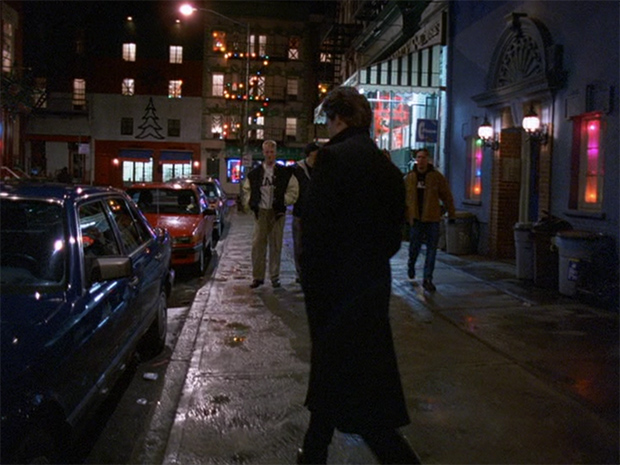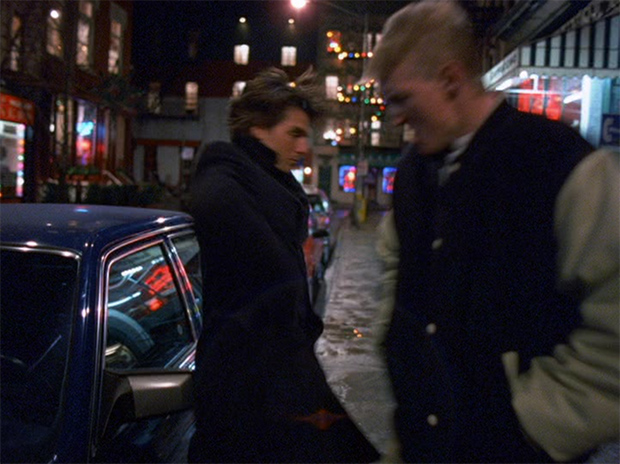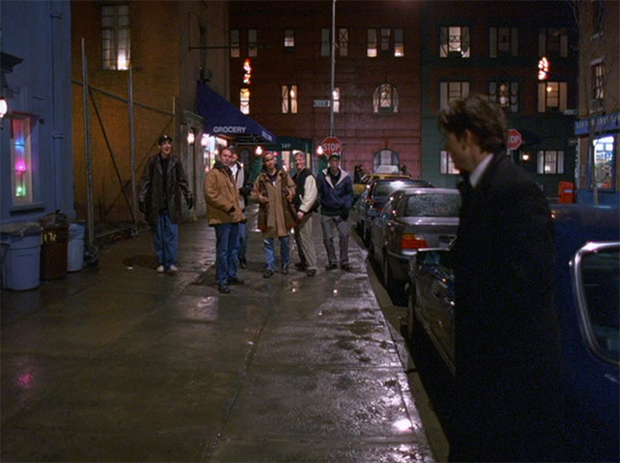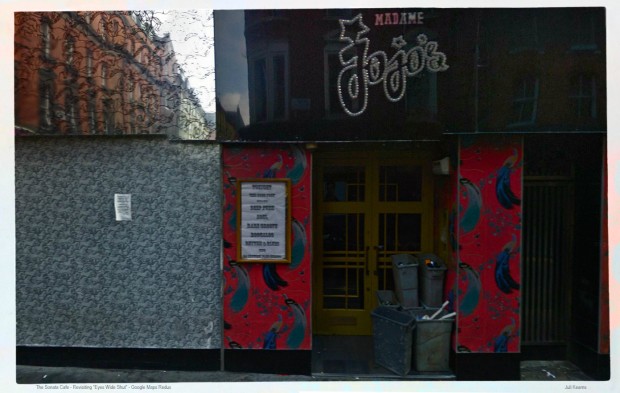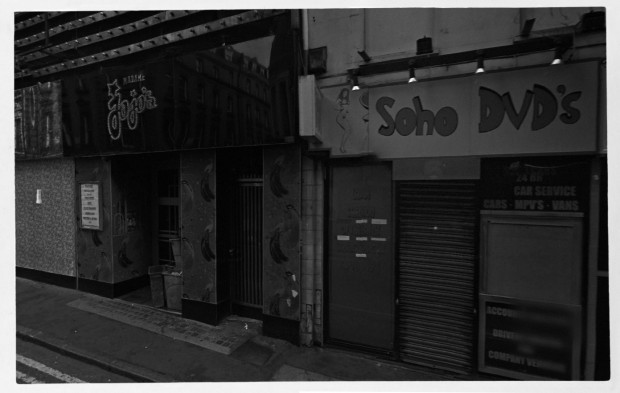Kubrick's Eyes Wide Shut:
THE SONATA JAZZ CAFE, MADAME JOJO'S, NUMBER 10, THE RAINBOW, AND DOWNING STREET
Go to TOC for this film ( (which has also a statement on purpose and manner of analysis and a disclaimer as to caveat emptor and my knowing anything authoritatively, which I do not, but I do try to not know earnestly, with some discretion, and considerable thought).
EWS screengrab
Not only are the streets and facades reused in Eyes Wide Shut, so that Bill passes through the same area over and over, the only slightly transformed buildings linked in their various incarnations, these buildings also have linkages to others. For instance, I've demonstrated this with Victor's billiard's room being linked with the Nathanson apartment through having the same wood work as in a room only barely glimpsed in the first Nathanson scene in which Bill arrives after Lou's death. Also, the rug in the Harford's dressing room is the same one that is under the glass-topped coffee table in the dressing area of the Rainbow.
People usually become aware of the streets and facades being reused when they see the neon arrow pointing to Gillespies and the sax neon for the Sonata Jazz Cafe reflected in the window beside the Rainbow costume shop. They are aware that Bill has taken a taxi to the costume shop from the cafe and that this wouldn't be necessary if the costume shop was directly opposite the cafe. The arrow for the diner, reflected on the window, points into the apartment of Millich, located just across the hall from the Rainbow. Millich is the current owner.
EWS screengrab
Below is the Rainbow as seen during the day when Bill returns his costume after the party. The building address is twice identified as #10, once on the facade and once on the door. The previous evening, the #10 had not been on the door.
Millich's, who owns the Rainbow, lives in an apartment across the hall. We can see that this is impossible as that area belongs to a neighboring building.
EWS screengrab
Below is from when Bill earlier passed down another version of this street and had an altercation with the Yale boys. The Rainbow is instead a cappuccino place with a striped awning, but above it we can discern a little of the name it will have in a later incarnation, anticipating when this facade will later be the Sharky's coffee shop. The building next to it is now painted blue and has a version of a fanlight transom with the windows of the fanlight either filled in or painted blue.
Here we have a phone sign positioned between the cappuccino place and the blue building. If you look back up at the reflection of the Sonata Jazz Cafe and Gillespie's Diner in the window leading to the Rainbow, we can see that this phone could be interpreted as anticipating the reflection of the red neon saxophone.
EWS screengrab
When Bill is bumped into by the Yalies he is thrown into a car. We've a jump cut and we see perhaps a foreshadowing of the Rainbow costume shop in car's window bending its reflection of the cappuccino place so that it is curved like a rainbow.
EWS screengrab
We also have a reverse shot looking back down the street in which we again see the blue building but not its fanlight. The xmas lights in the right window have been replaced with an upside-down configuration of the lights originally in the left window. I won't focus on this, I'm just mentioning it as far as fitting in with a pattern of reversals and reflections, as is had in all of Kubrick's films.
EWS screengrab
The Sonata Jazz Cafe was based on a famous gay/trans club called Madame Jojo's, located at 8-10 Brewer Street. Below we see it in more recent years on the left side of the street.
This address was once Isow's NY style deli restaurant which was popular with the entertainment industry and celebrities. The nightclub, Jack of Club's, named for Jack Isow, was in the basement. Isow's ran the club from about 1938 to 1972. I have no idea if Kubrick may have been aware of the Jack of Clubs and may have been interested in this history due his scene in Killer's Kiss based on one in the Orson Welles' film for Himberama in which the Jack of Spades was the card chosen and foretold in a magic act.
Google screengrab
The #8-#10 address of Jojo's combines it with the building that's on the left. We know this from an earlier photo of JoJo's from around the 90s.
A fun aside, servers who doubled as performers in the cabaret were called the Barbettes, after a female impersonator performer who was inspiration to Man Ray and Jean Cocteau, appearing in Cocteau's Le Sang d'un Poete.
Cocteau wrote of Barbette in the essay "Le Numero Barbette":
Barbette transforms effortlessly back and forth between man and woman. His female glamour and elegance Cocteau likens to a cloud of dust thrown into the eyes of the audience, blinding it to the masculinity of the movements he needs to perform his acrobatics. That blindness is so complete that at the end of his act, Barbette does not simply remove his wig but instead plays the part of a man. He rolls his shoulders, stretches his hands, swells his muscles...And after the fifteenth or so curtain call, he gives a mischievous wink, shifts from foot to foot, mimes a bit of an apology, and does a shuffling little street urchin dance – all of it to erase the fabulous, dying-swan impression left by the act.
Source: Wikipedia
This is the magic of theater, which Kubrick too pursues and displays in film after film.
Google screengrab
I've altered and blocked out part of the below photo as it originally accompanied a Guardian article. We see in it Madame Jojo's on the right and that it at that time was also part of what later became Soho DVD's, but that appears to have been 6 brewer Street. On the other side of Madame JoJo's is a club called Number 10.
Note that Number 10 has the accompanying image of a door with a fanlight above it. Remember that the Rainbow is #10 and in one of its incarnations the neighboring residential building has above its door a fanlight. This fanlight has only 6 windows.

Image from the Guardian, photo by Gianni Muratore
Though the fanlight of the door of the Number 10 Club has only 6 windows, it is obviously, cheekily intended to bring to mind the famous #10 Downing Street, "headquarters of Her Majesty's Goverment and the official residence and office of the First Lord of the Treasury, a post which for much of the 18th and 19th centuries and invariably since 1905, has been held by the Prime Minister." As quoted from Wikipedia.
So, was Kubrick aware of Club Number 10 that was at one time next Jojo's? Was Kubrick beefing up the "Those were not just ordinary people..." portion of the script by taking advantage of Madame Jojo's adjoining the Number 10 Club?
There is one other fanlight doorway in Eyes Wide Shut. The Number 10 door has a lion knocker. The entry doors to Somerton have lion knockers. I'm not aware where the below shot was filmed. The long shot is Mentmore Towers but the CU of the door is not Mentmore.
EWS screengrab
Cut from the entry to the interior and we see the door is not the same as the exterior. Bill passes under a fanlight transom as he progresses through and eventually into Elveden Hall's grand Marble Hall.
EWS screengrab
I have always taken the lime section in the drink at The Sonata Jazz Club, when we're shown the password, FIDELIO, as anticipating the fanlight at Somerton and probably referring also to the fanlight of the blue building where Bill is accosted by the Yalies, and which in another incarnation is Millich's home beside the Rainbow costume shop.
It's only now that I look at FIDELIO and see in it, at the end, #10 as well.
EWS screengrab
My interpretation of the film has been on the theatrical Dionysian/mystery religion side. In all of Kubrick's films that I've closely examined (I've not done Dr. Strangelove or Full Metal Jacket) we've an underworld journey that is flanked by evergreens, Bill's trip to Somerton anticipated by the wave of the counter ending on an evergreen at his medical office, the taxi ride switching at a mortuary to evergreens, and Bill, seemingly unwittingly, stepping into the real physical spotlight at Somerton which puts the emphasis on him as a special guest to this peculiar metaphysical/psychic territory to which he has been especially invited, but from which he is also specifically forbidden. Kubrick gives us the same trip in Lolita to the Enchanted Hunters Hotel, and also with The Shining and the trip to the isolated Overlook. With each of these places there is the underworld's anticipation of the trespass, the journeyers expected and welcomed and threatened all at once. The terrain excavated by Schnitzler's Traumnovelle and Glück‘s filmic interpretation of it is also underworld and dreamlike. This is the initiation of journey of Aeneas as referred to in Barry Lyndon and its ties to Stourhead garden, in which one is warned at the beginning of one's journey, "Begone, you are are uninitiated, begone", but the design is that one should progress and experience the underworld, the knowledge of which can not be taken back with one to the everyday world in any rational fashion, and so by its nature is always private.
Schnitzler's Traumnovelle does bring in the Vehmic court, yet still it is in the dreamlike experience as had in Sir Walter Scott's "Anne of Geirestein" in which the entry to the court is had via one's bed, and carries the uncertainty of dreams and the hazy otherworldiness of nightmares so vivid they become reality.
If Kubrick does associate Bill's Rainbow experience with Number 10 Downing Street (government and elites) via Madame Jojo's, it's to be remembered that in nearly all his films there is the collision between the elite and the common person. It was had in Paths of Glory, the upper brass brutally using trench soldiers with no regard for their lives. We have it in The Shining with the hotel having once been a hang-out of the elite and their ghosts still demanding the absolute sacrifice of self of the common servant. In Barry Lyndon, Barry does battle with the elites in a vain effort to establish himself among their number and fails. They only use him for his money. Those with wealth and power function as near gods, amoral in the way that dreams and archetypes can be amoral, even seemingly immoral, much like the ways of the impersonal universe the wheels of which appear to so cruelly crush its creatures that quest for justice.
Google map of location.
1920 words or 4 single-spaced pages. A 14 minute read at 130 wpm.
Go to Table of Contents of the EWS analysis
Link to the main film page for all the analyses




